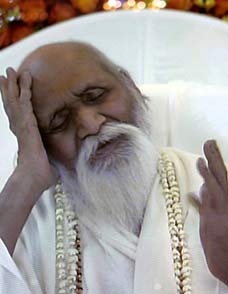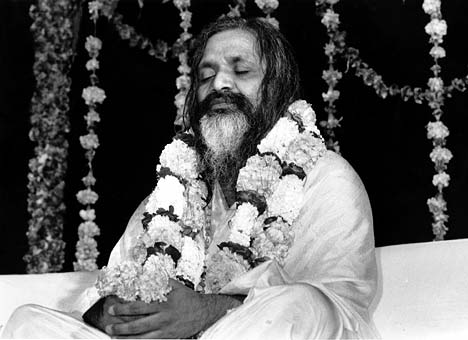
So which one was the real Maharishi Mahesh Yogi? Was he the enlightened saviour he always proclaimed himself to be?
Or the woollybearded, flower-bedecked fraud portrayed in Lennon's acid lyrics?
It's a debate that has lingered like the smell of burning incense for 40 years, ever since the Fab Four perplexed their fans by swopping flairs and kipper ties for flowing robes and love-beads.
And now that the Indian mystic's mortality has been proved with news of his death, at the approximate age of 91 (no one can be sure, for he dismissed birthdays as "an irrelevance"), it will doubtless resurface.
However, as the last writer to have been granted an audience with the enigmatic Maharishi - and, indeed, the only journalist to have been invited inside the strange "alternative nation" where he lived his final years in reclusion - I know who I tend to believe.
My day with the man who probably did more than anyone else to make traditional Eastern beliefs fashionable in the West came in March 2006, when I visited the so- called Global Country of World Peace, in Vlodrop, southeastern Holland.
It must rank as the most bizarre day of my 30-year career.
Before I take you behind the high walls of this closely-guarded community, however, it's worth remembering how an obscure Indian civil servant's son rose to control a vast spiritual fiefdom, with its own ministers and laws, and even its own currency, the Raam.
An empire, moreover, which became hugely lucrative thanks to the one quality the Maharishi never liked to publicise - his remarkable business acumen - aligned to an utterly shameless willingness to put aside his principles and embrace the detested "material world" when it suited his own ends.
He spent his early years in Jabalpur, where he was born, probably in 1917 or 1918. Back then his name was plain Mahesh Prasad Varma, and, though his family were devout Hindus, there was nothing to suggest that he might become a world-renowned leader.
A bright boy, he gained a maths and physics degree - a qualification he would use with great ingenuity later in life, when he impressed (and invariably baffled) his followers by "explaining" the ability of meditation to change people's consciousness in complex scientific terminology.
By all accounts, his life changed course radically in his late 20s, when he met his great mentor - a "swami" or Indian religious teacher, called Guru Dev.
He joined the ageing holy man on a lengthy retreat in the Himalayas, where he was introduced to a new form of meditation.
When he emerged, he called himself "Maharishi".
Unlike Guru Dev, who was content to wander, barefooted and in ragged clothes, from village to village and subsist on the simple charity of those he taught, his pupil developed more grandiose ideas.
Whether because he thought it his duty to spread his newfound enlightenment to as many people as possible, as he later claimed, or because he had an eye to the main chance, in 1958 he left India on his first "global tour."
For obvious reasons, though, he based himself in Los Angeles.
In those days, California was a Mecca for the Beat Generation, and among these forerunners of the hippies, a plausible, exotic young guru preaching love and peace - and offering a way of achieving a "natural high" without the need for drugs - quickly became a cult hero.

Soon his popularity spread among stressed business executives seeking an alternative to psychiatry, whose methods he scorned.
"You must learn to take life less seriously and to laugh," he told them, chuckling as if he were privy to some sublime cosmic joke.
"The highest state is laughter."
Along with the adulation came money, of course.
At first, the Maharishi asked for nothing and, like his mentor Guru Dev, he lived off donations, albeit more substantial amounts than he would have received in India.
As his renown grew, however, he began to charge "tuition fees", realising his affluent audience could easily afford to pay for his words of wisdom.
With a wink and a giggle, followers were also encouraged to contribute towards his "expenses": printing costs, transport rental, the hiring of halls and so on.
In 1961, one rich woman blithely wrote him a cheque for $100,000: her contribution to a new ashram he wished to build in India.
Another wealthy couple, accountant Roland Olson and his publicist wife Helen, gave him free use of a plush house in Hollywood.
The "Giggling Guru" appeared uninterested in these vast sums and never discussed or handled money himself, leaving it to his disciples.
However, the burgeoning bank balance can hardly have escaped his all-seeing gaze.
By the "beautiful summer" of 1967, when he famously came to the attention of The Beatles, the Maharishi boasted a considerable following, including celebrities such as Mike Love of the Beach Boys (who became a teacher of Transcendental Meditation), folk singer Donovan, Mia Farrow, and even the tough-guy actor Clint Eastwood.
Impressed after hearing him speak in London a few days earlier, on August 25, John, Paul, George and Ringo fatefully boarded a train from Paddington to Bangor, where they were to spend the Bank Holiday weekend on retreat with him.
Disaster struck midway through the seminar, when news came through that Brian Epstein, The Beatles' manager, had died from a drugs overdose.
The group, who relied on him to orchestrate every aspect of their lives, were devastated, but the Maharishi treated his death as a minor mishap.
"He was sort of saying, 'Look, forget it! Be happy!'" remarked Lennon later, adding caustically: "F*****g idiot."
At the time The Beatles couldn't see through such insensitive behaviour.
It seemed only to confirm one of their new guru's favourite phrases (which became the title of a George Harrison LP): "All things must pass."
Desperate for an alternative to the increasingly crazy, pressure-cooker world they inhabited, and seeking a new guiding spirit with Epstein's passing, they became deeply immersed in the Maharishi's teaching.
So, the following February, 1968, the four beaming, flower-garlanded band-members flew to India, where they were to spend several months deepening their knowledge of Transcendental Meditation at his ashram in Rishikesh.
They were accompanied by their respective partners and joined by a veritable array of mantra-chanting stars, including Farrow and her sister, Prudence.
For the first few weeks, this intended spiritual awakening went well enough, but Ringo was first to depart - he hated Indian food and his wife, Maureen, couldn't bear the insects.
After five weeks, amid mounting mutterings that the Maharishi was a publicity-seeker with an unhealthy interest in meditating in close proximity to the Farrow sisters, Paul McCartney followed the drummer back to London.
That left John and George, always the most receptive (or gullible?) among the guru's pupils.
In an episode now etched in Beatle folklore, however, they, too, packed their bags in disgust after Mia Farrow fled the Maharishi's cave in tears, claiming that the supposedly celibate swami had grabbed her in his hairy arms and tried to make advances towards her.
"Boys! Boys! What's wrong? Why are you leaving?" the Maharishi is said to have shouted after them.
"If you're so f*****g cosmic, you'll know," came Lennon's withering reply.
Scroll down for more...

Thus ended The Beatles' brief dalliance with the Maharishi. Or, at least, so it was widely believed.
The Maharishi always disputed this highly unedifying version of events.
In his one public pronouncement on the matter, he insisted that they were "too unstable and weren't prepared to end their Beatledom."
This stand-off rumbled on for almost four decades, casting a huge question-mark over the Maharishi's credibility and the entire TM movement.
But then, two years ago, the guru's story appeared to be given credence by the self-help guru Deepak Chopra (one of the Maharishi's former disciples).
The Maharishi had actually ordered The Beatles to leave the ashram, Chopra said, because they refused to stop taking drugs.
Chopra had just made his pronouncement when, quite unexpectedly, I was given the opportunity to hear the truth from the horse's mouth.
The Maharishi had not granted an interview since 1992, but after days of negotiations with his moony-eyed media chief, Bob Roth, I was summoned to the Global Country of World Peace.
No passport was required as I "left Holland" and drove to the Giggling Guru's kingdom, but it really was like entering another state; or rather, a parallel universe.
Inside the spacious compound, all the men (I saw no women) wore identical fawn- coloured suits and disconcerting, far-away smiles.
They were polite enough, but the place seemed utterly devoid of warmth.
However, Roth, a reconstructed San Francisco hippie in his 50s, repeatedly assured me that, for all manner of reasons, my karma was "just perfect for this interview".
But all this transparent schmoozing came with a warning.
Questions about His Holiness's personal life were strictly off limits.
Oh, and The Beatles were an absolute taboo.
This didn't seem to leave much room for discussion, but there were more surprises in store.
For the historic interview I was ushered into the so-called brahmastan, a sort of giant pagoda-style wooden palace. I was flanked by two sternfaced, light-suited "ministers", who introduced me, to the untold thousands of disciples watching this bizarre charade via the live global video-link by which the Maharishi communicated his edicts, as a "distinguished international journalist" - which was certainly a first for me.
Then, just as I was expecting him to make his entrance, a giant screen flickered to life and I was greeted not by a real live guru but by a sort of hologram with a cotton-wool beard and a shiny, teak-brown pate.
Only then did I realise that the Maharishi would be addressing me only via closed-circuit TV from his chamber, presumably somewhere upstairs.
"His Holiness never meets anyone because his doctor is concerned that he might catch germs," Roth whispered.
"He hasn't been outside for years."
In truth, it was more a monologue than an interview.
The Maharishi spouted incomprehensible mumbo jumbo for several minutes-then launched into a diatribe against Britain - a terrible country which believes in "divide and rule" and was responsible for much of the misery besetting the world.
This, he said, was why he had decided to "excommunicate" this country, meaning that his disciples were banned from teaching TM here (a state of affairs which, I regret to report, he later reversed).
My one small victory was that I managed to ask him - ever so politely - about The Beatles.
Given all the bad blood, did he regret his involvement with the band who made him a household name?
Suddenly, all that serenity evaporated and the mystic came over all mortal.
"Forget about it!" he spluttered furiously.
"If at all, (The) Beatles became substantial by my contact.
"I did not become great by association of The Beatles! Beatles make Maharishi great? Pah! It is a waste of thought."
Perhaps so, but there's no denying that this trivial "waste of thought" is one good reason why the Maharishi leaves behind in trust an estate conservatively said to be worth some £600 million.
A few weeks ago, with extraordinary prescience perhaps, the mystic handed control of the TM movement to his anointed successor, a little-known Lebanese, former research scientist named Maharaja Nader Ram (formerly Dr Tony Nader).
But his peaceful passing, I am assured, will have little noticeable effect on the empire he created, with its hefty bank balance and estates, including a huge campus university in Iowa.
Meanwhile, with the charge for a three-day TM induction course now running at £1,280, the Giggling Guru's well-heeled "ministers" will doubtless go on living in the material world.
All they need is love, maybe. But money - that's what they want.
David Jones